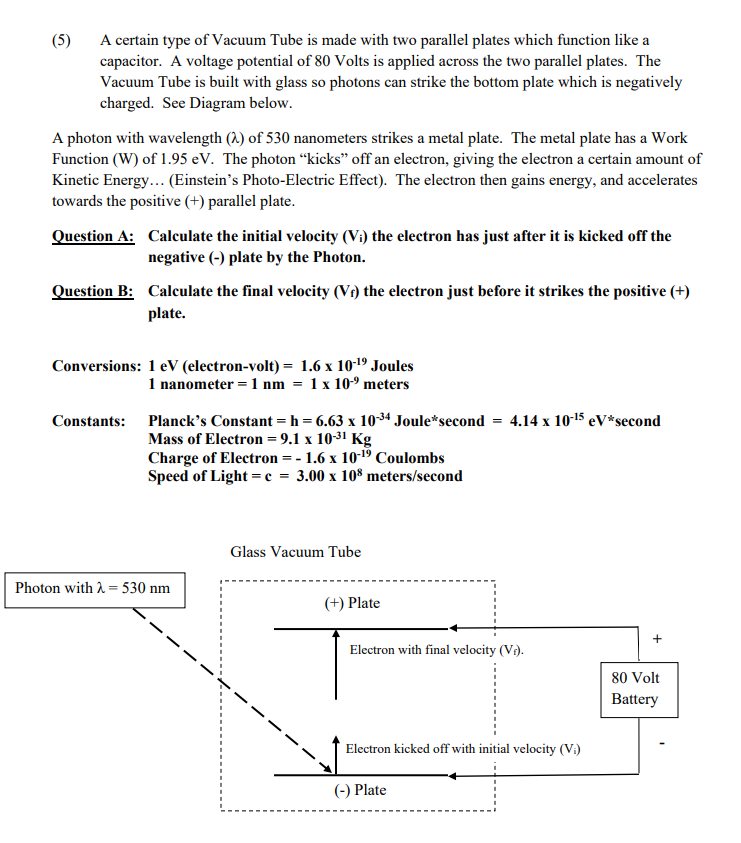A photon with wavelength (2) of 530 nanometers strikes a metal plate. The metal plate has a Work Function (W) of 1.95 eV. The photon “kicks" off an electron, giving the electron a certain amount of Kinetic Energy... (Einstein's Photo-Electric Effect). The electron then gains energy, and accelerates towards the positive (+) parallel plate. Question A: Calculate the initial velocity (Vi) the electron has just after it is kicked off the negative (-) plate by the Photon. Question B: Calculate the final velocity (Vr) the electron just before it strikes the positive (+) plate.
A photon with wavelength (2) of 530 nanometers strikes a metal plate. The metal plate has a Work Function (W) of 1.95 eV. The photon “kicks" off an electron, giving the electron a certain amount of Kinetic Energy... (Einstein's Photo-Electric Effect). The electron then gains energy, and accelerates towards the positive (+) parallel plate. Question A: Calculate the initial velocity (Vi) the electron has just after it is kicked off the negative (-) plate by the Photon. Question B: Calculate the final velocity (Vr) the electron just before it strikes the positive (+) plate.
Principles of Instrumental Analysis
7th Edition
ISBN:9781305577213
Author:Douglas A. Skoog, F. James Holler, Stanley R. Crouch
Publisher:Douglas A. Skoog, F. James Holler, Stanley R. Crouch
Chapter25: Voltammetry
Section: Chapter Questions
Problem 25.15QAP
Related questions
Question
Help me please

Transcribed Image Text:(5)
A certain type of Vacuum Tube is made with two parallel plates which function like a
capacitor. A voltage potential of 80 Volts is applied across the two parallel plates. The
Vacuum Tube is built with glass so photons can strike the bottom plate which is negatively
charged. See Diagram below.
A photon with wavelength (2) of 530 nanometers strikes a metal plate. The metal plate has a Work
Function (W) of 1.95 eV. The photon “kicks" off an electron, giving the electron a certain amount of
Kinetic Energy... (Einstein's Photo-Electric Effect). The electron then gains energy, and accelerates
towards the positive (+) parallel plate.
Question A: Calculate the initial velocity (Vi) the electron has just after it is kicked off the
negative (-) plate by the Photon.
Question B: Calculate the final velocity (Vr) the electron just before it strikes the positive (+)
plate.
Conversions: 1 eV (electron-volt) = 1.6 x 10-19 Joules
1 nanometer = 1 nm = 1 x 10° meters
Planck's Constant = h = 6.63 x 1034 Joule*second = 4.14 x 10-15 eV*second
Mass of Electron = 9.1 x 10-31 Kg
Charge of Electron = - 1.6 x 10-19 Coulombs
Speed of Light = c = 3.00 x 108 meters/second
Constants:
Glass Vacuum Tube
Photon with 2 = 530 nm
(+) Plate
+
Electron with final velocity (V).
80 Volt
Battery
Electron kicked off with initial velocity (V.)
(-) Plate
Expert Solution
This question has been solved!
Explore an expertly crafted, step-by-step solution for a thorough understanding of key concepts.
Step by step
Solved in 2 steps with 1 images

Knowledge Booster
Learn more about
Need a deep-dive on the concept behind this application? Look no further. Learn more about this topic, chemistry and related others by exploring similar questions and additional content below.Recommended textbooks for you

Principles of Instrumental Analysis
Chemistry
ISBN:
9781305577213
Author:
Douglas A. Skoog, F. James Holler, Stanley R. Crouch
Publisher:
Cengage Learning


Principles of Modern Chemistry
Chemistry
ISBN:
9781305079113
Author:
David W. Oxtoby, H. Pat Gillis, Laurie J. Butler
Publisher:
Cengage Learning

Principles of Instrumental Analysis
Chemistry
ISBN:
9781305577213
Author:
Douglas A. Skoog, F. James Holler, Stanley R. Crouch
Publisher:
Cengage Learning


Principles of Modern Chemistry
Chemistry
ISBN:
9781305079113
Author:
David W. Oxtoby, H. Pat Gillis, Laurie J. Butler
Publisher:
Cengage Learning

Chemistry: Principles and Practice
Chemistry
ISBN:
9780534420123
Author:
Daniel L. Reger, Scott R. Goode, David W. Ball, Edward Mercer
Publisher:
Cengage Learning

Chemistry for Engineering Students
Chemistry
ISBN:
9781285199023
Author:
Lawrence S. Brown, Tom Holme
Publisher:
Cengage Learning